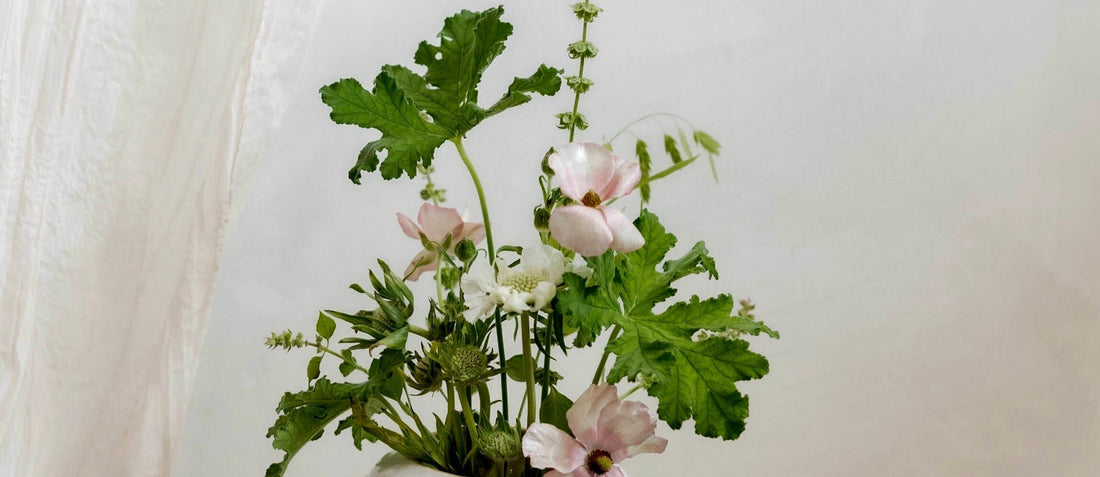
Sophia Smith: From Corporate to Creative, A Florist’s Journey Through Ikebana
We first met Sophia Smith when she became a Flower Club member while living in the United States and began attending our online Ikebana Club sessions. Since then, her floral journey has taken her across continents. What began as a temporary flower shop job after leaving corporate life has become a globe-spanning career filled with artistry, nature, and growth. Now based in Munich, Sophia works as the Floristik Manager at a leading event design company and is deepening her passion for ikebana through the Ikebana Academy, where she’s studying to become a certified Sogetsu ikebana artist.
In this interview, she reflects on her evolving style, creative inspirations, and the quiet power of floral design.

How did your journey with flowers begin, and what projects are you currently working on with flowers?
I left a corporate job in 2022 and started a seasonal job at a flower shop in my hometown. It was just meant to be temporary, but five years later the flowers have taken me to Kansas City, then Aspen, Mexico City, rural Belgium, Verona, and Munich.
I have recently moved to Munich, and have begun working as the Floristik Manager at an Event Design company here. I’m working on mastering the company’s contemporary creative style and seeing what I have to add, German names for flowers, and German brides preferences/culture. In my free time, I have enrolled in a Sogetsu course and want to work on my flower photography.
What first drew you to study ikebana?
I discovered ikebana while working at a small shop in Kansas City. They had some ikebana-inspired products and I was quite good at designing in that style. My interest in more official knowledge and training began there, and I started with some library books and youtube before finding Flower Club International.
What benefits have you found from studying ikebana so far?
Ikebana encourages me to slow down with designing. So much of my day to day work is about speed, proficiency, and quality, relying on muscle memory to get things done. Ikebana shifts focus to seasonality, beauty of materials, and movement. It’s like a deep exhale at the end of a long day.
 What do you love most about working with flowers?
What do you love most about working with flowers?
Flowers were the first thing that fulfilled my creative drive. They are beautiful, but the industry is a combination of botany, math, design, etc. I’ve seen people from all different backgrounds contributing different things to the conversation that is floral design.
How would you describe your style of floral art?
I love when my (personal) work feels like a whimsical, wild garden bed, with little surprises and textures.
Do you have a favourite material or season to work with?
Autumn is my favorite season with its colors and textures, but delicate Spring blooms like iris and tulip I also find very romantic.
Where do you usually source your flowers, vases, and tools?
For flowers, I prefer locally-grown or foraged, but I also will take them from the Munich Blumengrossmarkt. For vessels, this area of Germany has a thriving ceramic artist community so I am growing my collection from them. Many of the tools are from Japan and were gifted from my sweet partner.
 Which floral or ikebana artists inspire you most?
Which floral or ikebana artists inspire you most?
Hyssop Floral, Aesme Studio, Studio Pasquale, and Flowers by Ford are some of my favorites. I am still discovering Ikebana artists.
What’s the best advice you’ve received on your flower journey?
Study principles of art and learn to see negative space as a tool, observe how flowers grow in garden beds and sidewalks
What advice would you give to someone starting ikebana or floral design?
Be willing to not be good at first. Instead, copy good form until you can do it yourself. Ask for feedback. Journal.
Any favourite tips or techniques you'd share with beginners?
Find/create opportunities to learn from more experienced florists or business owners.

What’s the biggest difference between Western and Japanese floral design?
In Western floral design, generally there is a lot of emphasis on the customer's perception of value. Big blooms and long stems are a part of that. Japanese floral design seems to place more emphasis on the feeling and symbolism of each piece.
What challenges do you face working with flowers professionally?
Restraining myself from buying each flower that speaks to me. The beauty and skill draws me to this industry, but the math is what keeps your business afloat. Imposter syndrome is a big one. Taking good photos for my portfolio.
Where should flower lovers go in your city for a 24-hour visit?
The Englisher Garten and the Munich Botanical Gardens at Nymphenburg are a must-see. My partner took me on my first visit to Munich. I would also visit the Alte Pinakothek for the art inspiration.
What’s next for you in your flower journey?
I want to spend this year honing my skills and learning the new market/culture I am in. I want to focus on how I function as a professional leading a team. Develop my ikebana practice. I’d like to work on my personal and professional portfolios and take every opportunity for workshops/time with other creatives. After that, who knows?

Sophia’s journey reminds us that creativity blooms where courage and curiosity meet. From her early days with Flower Club to her current life in Germany, she’s continued to explore the language of flowers with grace and dedication. As she studies to become a certified Sogetsu ikebana practitioner through our Ikebana Academy, we’re honored to be part of her path. Follow Sophia on Instagram at @bougieblooms_.
Photo credit to : Gracefully Made in KS
